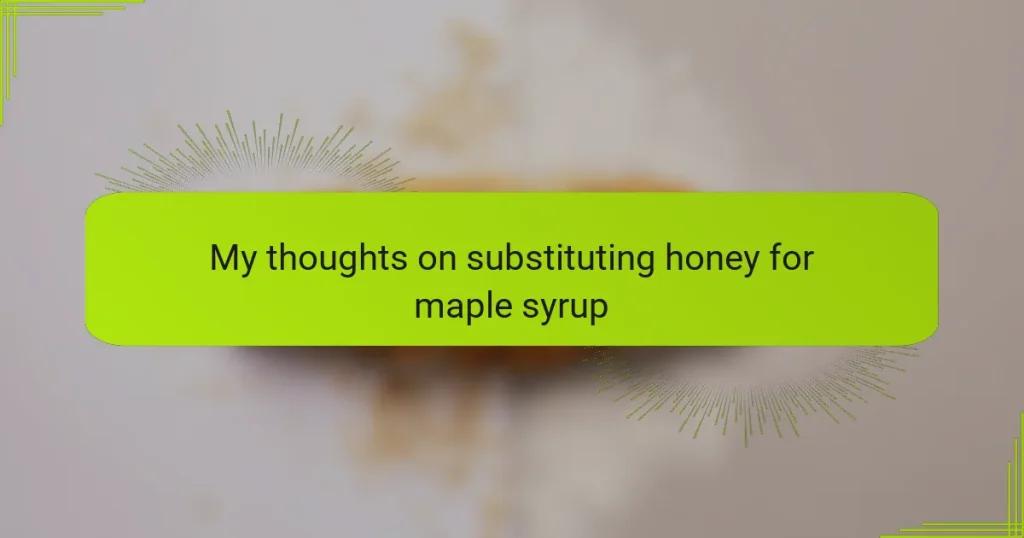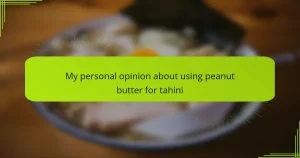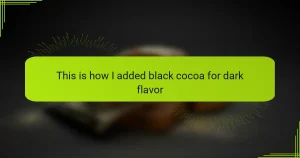Key takeaways
- Honey and maple syrup have distinct flavors and textures that significantly impact baking outcomes; honey is thicker and floral, while maple syrup is lighter and woody.
- When substituting honey for maple syrup, reduce the amount to about three-quarters and warm the honey to ensure better mixing.
- Swapping sweeteners can change not just sweetness but also the texture and overall experience of a dessert, making experimentation valuable.
- Popular dessert recipes like baklava, fruit crisps, and lemon drizzle cakes can be enhanced by using honey instead of maple syrup, highlighting its unique qualities.
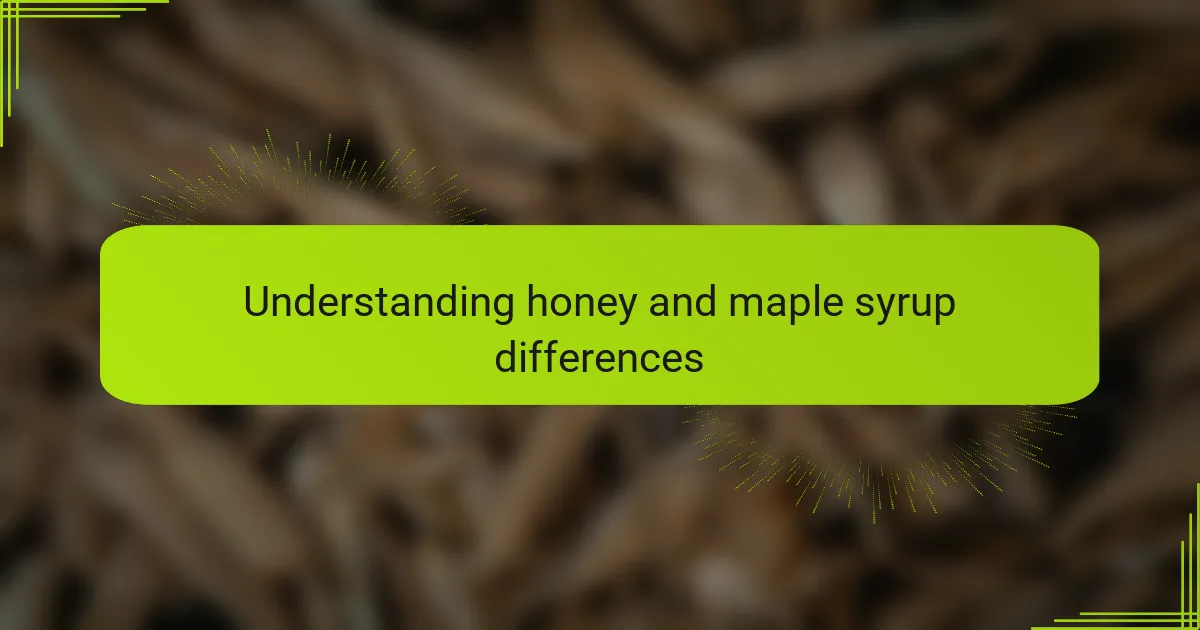
Understanding honey and maple syrup differences
When I first started experimenting with desserts, I didn’t realize how distinct honey and maple syrup truly are. Honey is thicker and has a floral, sometimes slightly tangy flavor, while maple syrup is thinner with a warm, woody sweetness. Have you ever wondered why your cake tastes different when you swap one for the other? That contrast isn’t just in flavor—it’s in texture too, which can subtly change your recipe’s outcome.
From my experience, understanding these differences helps manage expectations in baking. Honey’s moisture content can make a batter denser, whereas maple syrup might keep it lighter. I recall a time when I replaced maple syrup with honey in a pancake recipe and ended up with a heavier, stickier stack—delicious, yes, but not quite what I intended. This taught me that knowing their unique properties can guide better substitution choices.
It’s fascinating how both are natural sweeteners, yet their production processes influence their characteristics so much. Honey comes straight from flowers, carrying those delicate nuances, while maple syrup is boiled down from sap, giving it that caramelized depth. Recognizing these origins helps me appreciate their flavors more and decide when each one best suits a dessert. Have you noticed this with your own cooking?
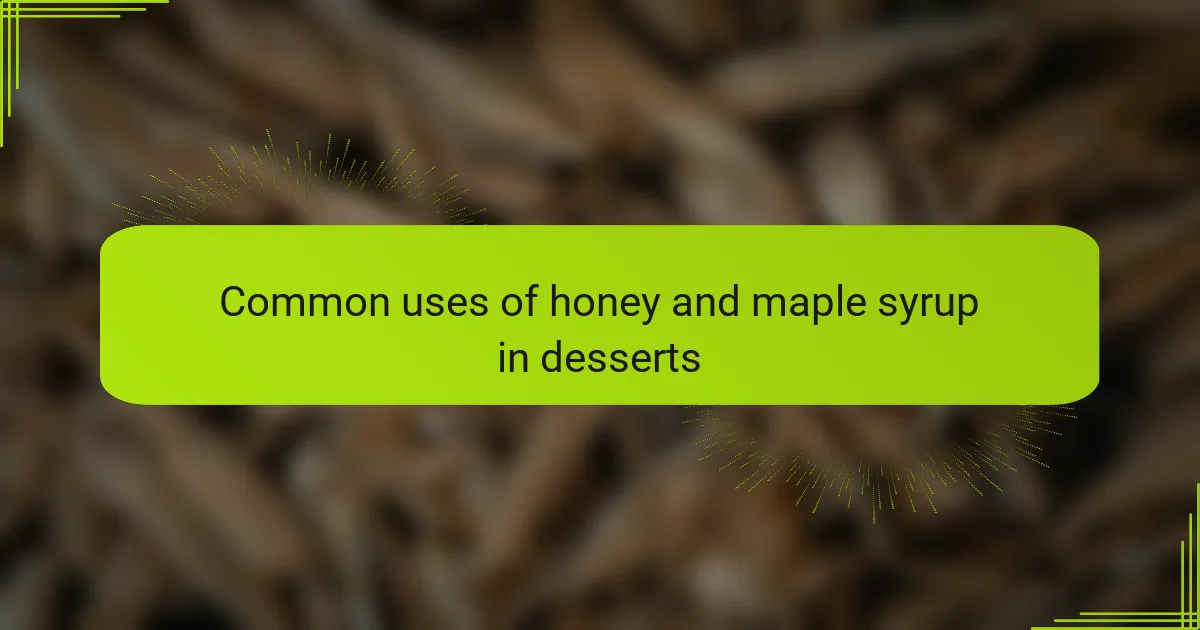
Common uses of honey and maple syrup in desserts
Both honey and maple syrup often show up in my dessert experiments, especially as natural sweeteners in cakes, cookies, and glazes. Honey’s thicker texture makes it ideal for drizzling over warm desserts like baklava or yogurt parfaits, where its floral notes can really shine. Maple syrup, with its lighter consistency, frequently stars in recipes for pancakes and waffles, infusing a comforting, woody sweetness that feels like a cozy hug on a chilly morning.
I’ve noticed that maple syrup is a go-to in autumn-inspired desserts—think pumpkin pies or spiced muffins—adding a subtle caramel flavor that complements warm spices beautifully. Honey, on the other hand, often takes center stage in recipes calling for a touch of floral brightness, like lavender shortbread or lemon drizzle cake. Have you ever savored that delicate contrast honey brings to a dessert, transforming the whole experience?
Sometimes, I swap one for the other in my kitchen just to explore how they affect texture and sweetness. Using honey in a fruit salad dressing or custard can add a richer, more complex sweetness, whereas maple syrup’s syrupy flow works wonders in glazing nuts or roasted fruits. These small shifts keep my dessert creations interesting and remind me that both sweeteners have their special roles in the sweet world.

How substituting affects dessert flavor and texture
Swapping honey for maple syrup in desserts often shifts the flavor in ways that surprise me. Honey’s floral and sometimes tangy notes can brighten a recipe, creating a more complex taste, whereas maple syrup lends a warm, caramel-like undertone that feels deeply comforting. Have you ever noticed how a drizzle of honey can suddenly make a simple cake feel more vibrant?
Texture-wise, I’ve found that honey’s thickness adds moisture and density to baked goods, sometimes making them a touch heavier than intended. Maple syrup, being thinner, usually lets cakes and cookies stay lighter and more tender. One time, I swapped honey into a muffin recipe originally calling for maple syrup and ended up with a denser crumb—but that richness was oddly satisfying.
The real fun, I think, is experimenting and seeing how each sweetener transforms not just taste but mouthfeel. Does the dessert become stickier? Does it keep that delicate crumb? For me, these subtle differences keep baking exciting, and they make me appreciate the unique qualities each syrup brings to the table. Have you tried this kind of trade-off in your own kitchen?
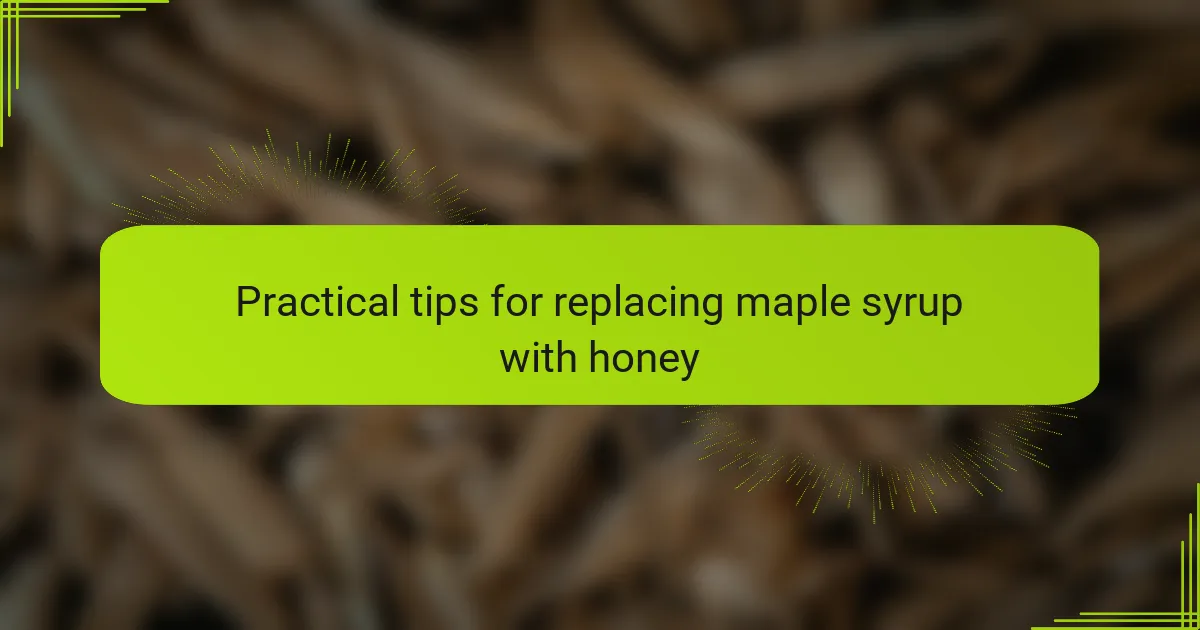
Practical tips for replacing maple syrup with honey
When replacing maple syrup with honey, I always adjust the quantity slightly—honey is sweeter and thicker, so using about three-quarters of the maple syrup amount usually works better. Have you ever noticed how that small tweak can prevent your batter from becoming overly dense or sticky? Trust me, this little change makes a big difference in achieving the right texture.
Another tip I’ve found helpful is to warm the honey gently before adding it to your recipe. Since honey is more viscous, warming it helps it blend more easily with other ingredients, especially in batters or dressings. I remember one time rushing to mix honey right out of the jar and ended up with uneven sweetness—a simple warming step saved me a lot of frustration after that!
Lastly, consider the flavor profile your dessert needs. Honey’s floral notes can sometimes overshadow delicate spices or fruits, so pairing it thoughtfully is key. If you want to keep the mellow warmth that maple syrup offers, I like to balance the honey with a dash of cinnamon or vanilla. Have you ever played around with spices to tone down honey’s boldness? It’s a game-changer in my kitchen.
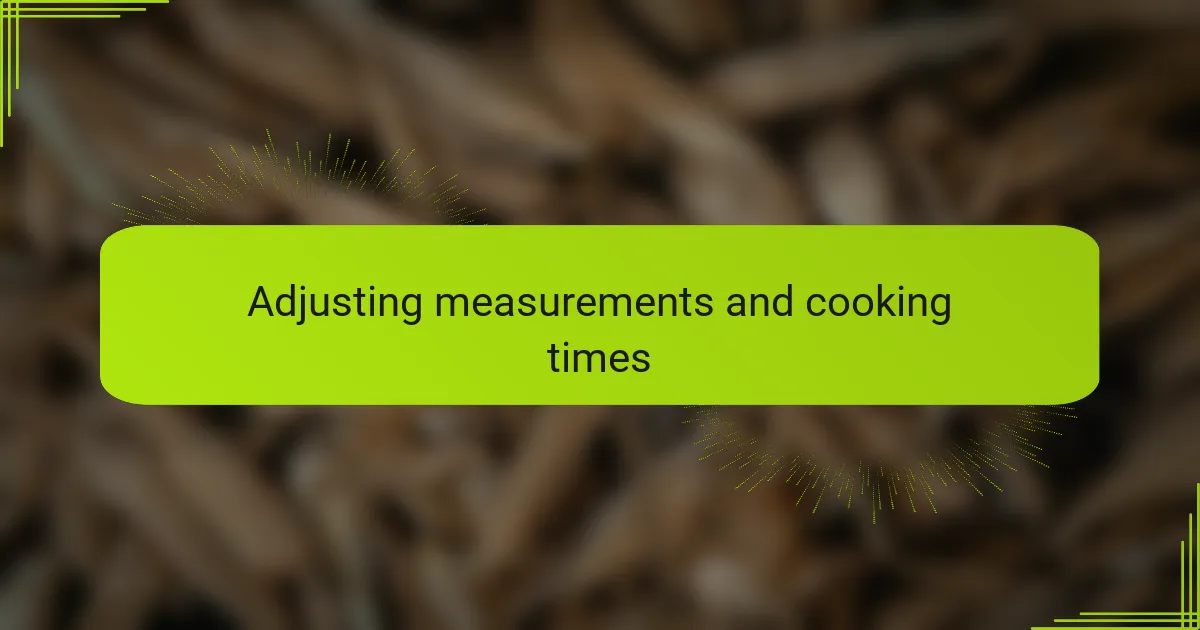
Adjusting measurements and cooking times
Adjusting measurements when swapping honey for maple syrup has always been a bit of a balancing act for me. Since honey is thicker and sweeter, I usually reduce the amount to about three-quarters of what the recipe calls for with maple syrup. Have you ever wondered why your batter feels too sticky or dense after a straight substitution? That small change saves the texture from tipping over.
Cooking times can also shift subtly because honey caramelizes faster due to its higher sugar content. I remember baking cookies where using honey caused the edges to darken earlier than expected, so I had to lower the oven temperature slightly and keep a closer eye on them. Don’t you find it curious how a natural sweetener can change not just taste but also the baking rhythm?
Sometimes, I even tweak both measurements and cooking times simultaneously to get the perfect result. When I made a honey-sweetened cake in place of maple syrup once, shortening the bake by a few minutes prevented the crumb from drying out while still developing that lovely golden crust. Have you ever had to play detective with your oven in this way? It’s all part of the learning curve that makes dessert baking so rewarding.

Personal experiences with substitution results
When I first swapped honey for maple syrup in a batch of brownies, I was surprised by how much denser and moist they became. The texture was richer, almost fudge-like, which wasn’t what I expected but definitely enjoyable. Have you ever tried a substitution that changed a recipe in an unexpected but delightful way?
Another time, I used honey instead of maple syrup in a glaze for roasted pears and noticed the floral notes made the dessert feel lighter and more nuanced. It’s funny how such a small change can tilt the flavor profile so significantly. That experience taught me to think beyond sweetness and consider what emotional tone a dessert carries with each sweetener.
Sometimes, though, the results aren’t so perfect. Once, I rushed the substitution without adjusting the quantity, and the cake turned out heavy and overly sweet—proof that honey’s intensity demands respect in the kitchen. Have you had those “oops” moments that actually became valuable lessons for your next baking experiment? I know I have, and they’ve shaped how I approach substitutions ever since.
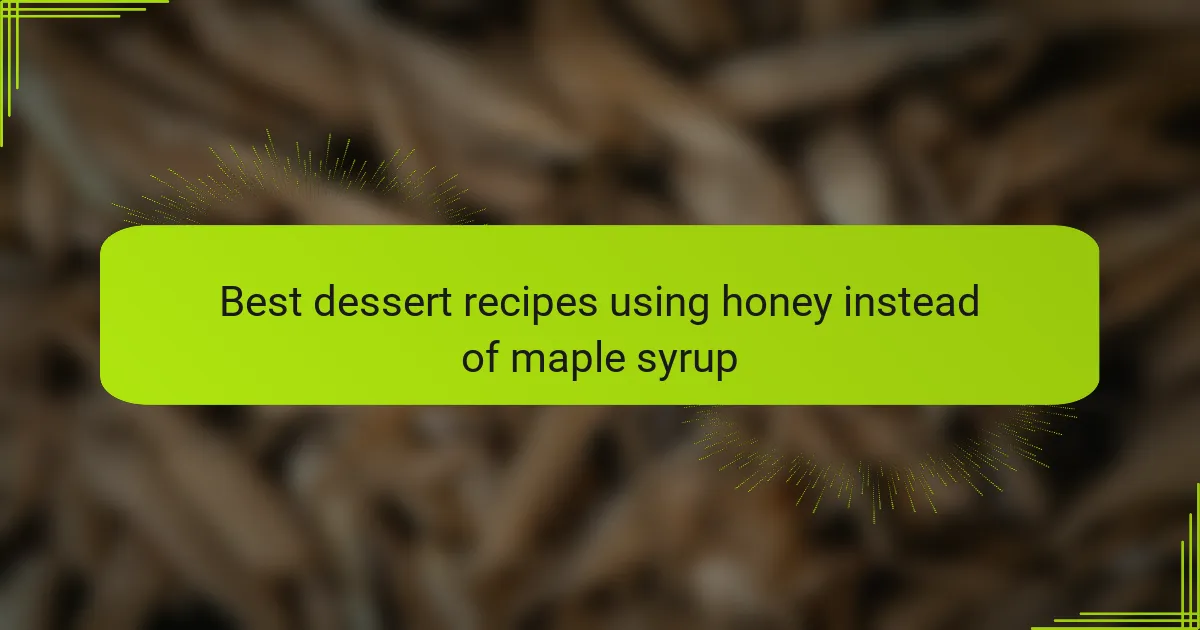
Best dessert recipes using honey instead of maple syrup
When I swap maple syrup for honey in dessert recipes, I often reach for honey-sweetened baklava or honey-glazed carrot cake. These desserts really benefit from honey’s floral complexity, adding layers that maple syrup just can’t replicate. Have you noticed how honey can turn a simple glaze into something unexpectedly aromatic and rich?
Fruit crisps and roasted nut toppings also shine with honey instead of maple syrup. The thicker consistency helps the topping caramelize beautifully without becoming too runny, which has saved my fruit crisps from sogginess more than once. I remember one autumn when my honey-glazed pecan crisp stole the show at a family gathering—everyone kept asking what made it taste so addictive.
Lemon drizzle cakes are another favorite of mine for honey substitution. The bright citrus paired with honey’s subtle tang elevates the dessert, creating a balance that feels fresh yet indulgent. Have you ever tried that combo? It’s like the honey adds a little sunshine to every bite, making the cake feel both comforting and lively.
